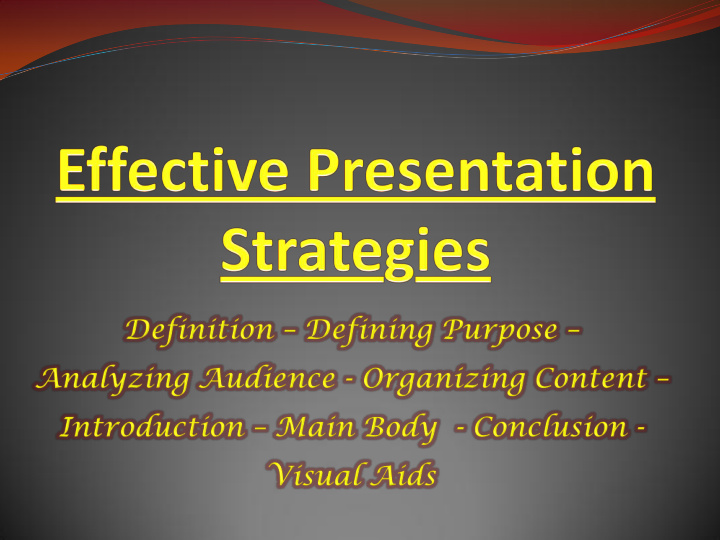



Oral Presentation “Half of of the the worl orld is is comp ompose osed of of pe people ople who ho hav have somethin something to to say say and and can’t, and the and he other ther hal half, who who have ave no nothin thing to to say and and keep on on sayin ing it it. ” - Robert Frost. Definition: An oral presentation is relatively formal kind of a talk requiring preparation and some amount of writing. Dave Mihir - C. S. - B. H. Gardi College - Rajkot
Defining Purpose Identifying Topic: The topic is a general outline of the subject. It should arouse interest. It should stand alone as a message. It should tell something about the presentation. Defining Purpose: Depending upon the your purpose of presentation – to inform, to analyze, or to persuade – one should be flexible enough to adjust to new inputs & unexpected audiences reactions. Dave Mihir - C. S. - B. H. Gardi College - Rajkot
Analyzing Audience Know Your Audience: What are their interests, likes and dislikes? Are they familiar with the topic? Is their attitude hostile or friendly? What’s the size of the group? Age range? Gender distribution? All All audi audience ences have ave on one thing thing in in commo common; they they are are at at the the receiving receiving end end of of the the pro process cess of of com ommuni unication cation. Dave Mihir - C. S. - B. H. Gardi College - Rajkot
Analyzing Audience Know More About Your Audience: Audience’s Knowledge of the subject: Do not repeat what people already know. Do not spend much time of basics. Audience’s relation with you: Be clear about your relation with the audience, e.g. subordinate or superior. Think about the responsibility and authority in relation to people you are addressing. Dave Mihir - C. S. - B. H. Gardi College - Rajkot
Analyzing Audience Know More About Your Audience: Audience’s Participation varies as follows: Purpose Audience’s Participation --- Low Moderate High Entertainment Ceremonial Informative Persuasive Dave Mihir - C. S. - B. H. Gardi College - Rajkot
Organizing Contents Always prepare more material than require, as this will help you feel confident. Arrange your contents into three parts: Introduction: Main Body: Conclusion: In other words, … Say Say wha hat you you want ant to to say say, say say it it; then say what you’ve already dy said. Dave Mihir - C. S. - B. H. Gardi College - Rajkot
Introduction of the Speech “The brain brain starts starts workin working the the mom moment ent you you are are born orn and and nev never er sto stops ps until until you you get up up to to speak in in public” - Anonymous An introduction must be brief & should state the subject. It should also capture attention, inspires confidence & preview the contents that follow. Dave Mihir - C. S. - B. H. Gardi College - Rajkot
Introduction of the Speech An introduction may be developed in the following ways: Ask a question Tell a story or anecdote Refer to the occasion Use quotation Use an unusual idea or comparison Express its usefulness Dave Mihir - C. S. - B. H. Gardi College - Rajkot
Main Body of the Speech Depending on the topic & introduction of the presentation, any of the following patterns of organizing the main body can be chosen: Chronological: e. g. “The Profile of X Institution”, “Changing Face of the Earth”, “History of Sports” Categorical: e. g. “Roll of Advertising”, “Environmental Protection”, “Importance of Presentation” Dave Mihir - C. S. - B. H. Gardi College - Rajkot
Main Body of the Speech Depending on the topic & introduction of the presentation, any of the following patterns of organizing the main body can be chosen: Cause & Effect: e. g. “Impact of Cinema on Children”, “Internet – Boon or Bane”, “Smoking in Youngsters” Problem – Solution: e. g. “The Global Warming”, “Population Explosion” Dave Mihir - C. S. - B. H. Gardi College - Rajkot
Conclusion of the Speech “A speech speech is is lik like a lov ove affa ffair, ir, any any fool fool can an start start one one but ut to to end end it it req requires uires consid idera erabl ble skill. ” - Lord Mancraft The conclusion of speech is almost as important as the beginning because people tend to remember what they hear first and last. The ending of the speech should be brief, forceful. Dave Mihir - C. S. - B. H. Gardi College - Rajkot
Conclusion of the Speech Indicate that you’ve reached the end with verbal clue: “In conclusion …” “To sum up …” “Let me conclude …” or “Before I conclude …” Use summary of your speech: Make an appeal: End on a positive note: Dave Mihir - C. S. - B. H. Gardi College - Rajkot
Visual Aids Spoken words are ephemeral, & because of this limitation, speeches often need strong visual support: Handouts, Chalk boards, Flip charts, Overhead Projector, PPT Slides, Charts & Tables Dave Mihir - C. S. - B. H. Gardi College - Rajkot
Visual Aids Importance of visual Aids: Increase interest in audience Illustrate key points Signal transition from one part of the presentation to the next Increase impact of the message Help listener retain information Help you to present ideas without depending on notes Better option in case of language & accent problem Dave Mihir - C. S. - B. H. Gardi College - Rajkot
Dave Mihir - C. S. - B. H. Gardi College - Rajkot
Recommend
More recommend